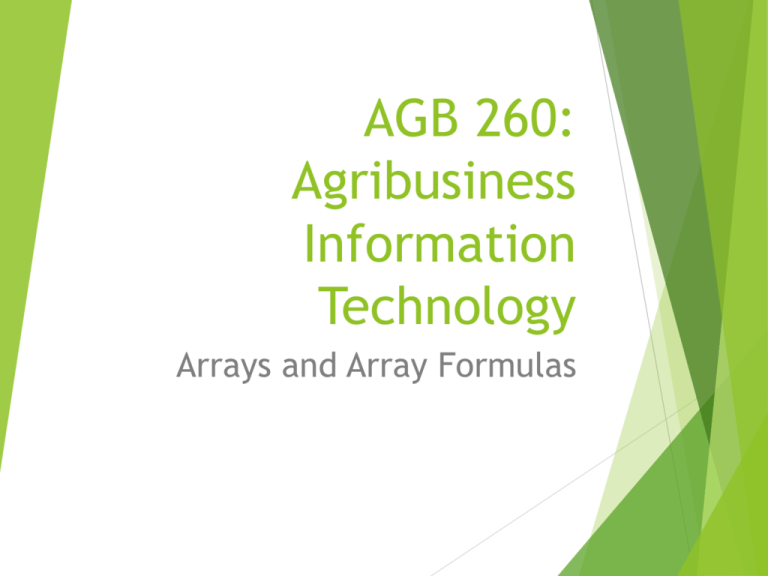PowerPoint
advertisement

AGB 260:
Agribusiness
Information
Technology
Arrays and Array Formulas
Useful Chapters in the Textbook
Regarding this Lecture
Chapter 17
Chapter 18
Arrays
An array is a collection of items
which can easily be represented as
cells in Excel spreadsheet.
Arrays in Excel can be one or two
dimensional which correspond to
the rows and columns of the
worksheet.
A one dimensional array can either
be one column or one row.
Arrays Cont.
A two dimensional array must have
both rows and columns.
An example of a one dimensional row
array:
{1,2,3,4,5}
Put this in a cell with an equal sign at the
beginning, highlight 5 cells in a single row,
press F2 and then CTRL-Shift-Enter
Arrays Cont.
An example of a one dimensional
column array:
{1;2;3;4;5}
An example of a 3x2 two
dimensional array:
{1,2;3,4;5,6}
Single-Cell Array Formulas
Single-cell
array formulas
These
formulas give a result in
one cell, e.g.,
={Sum(A1:A4*B1:B4)}.
When entering an array formula,
you must activate the cell and press
Ctrl+Shift+Enter
Single-Cell Array Formulas
Cont.
Suppose you have the names Bob,
Sean, and Stuart in cells A1:A3
If we want to calculate the average
length of individuals’ names, we
can do it in a single formula using
the idea of an array
=AVERAGE(LEN(A1:A3))
Multi-Cell Array Formulas
Multi-cell
array formulas
These
formulas give a result that
spans multiple cells.
In
these formulas, you need to
select the cells for where the
results will be and press F2 to
select the cells.
Transposing an Array
A useful array formula is the
Transpose function.
This function will take a column
array and make it a row array, a
row array into a column array, and
it will transpose a matrix array.
Frequency Function
The frequency() function calculates
the number of times a value occurs
in an array, i.e., it helps you create
a histogram.
It has two main arguments:
The
data_array argument is the array
of values your interested in
The
Bins_array is the array that has
the numbers to be tallied.
Linest Function
The Linest() function returns the
results of doing a linear regression
on a column array of known Y’s
regressed against an array of known
X’s.
Linear regression is based on the
concept Y = mx + b
Linest Function Cont.
There are four arguments to the function:
Known_y’s – this is the set of numbers for the
dependent variable
Known_x’s – this is the set of numbers for the
independent variable(s)
Const – If you set this to True, it will estimate a
nonzero intercept b; false implies set b to zero
Stats – True gives you a set of regression
statistics, while false returns no statistics
Matrix Functions
Excel has three useful matrix
functions:
Mmult()
which does matrix
multiplication of two arrays
Mdeterm()
which gives you the
determinant of a square matrix
Minverse()
which gives the inverse of a
square matrix
Matrix Functions Cont.
The functions can be useful when doing
matrix algebra, i.e., solving a set of
linear equations, but they can have
rounding issues
For example:
x+y= 80
x-y=20







